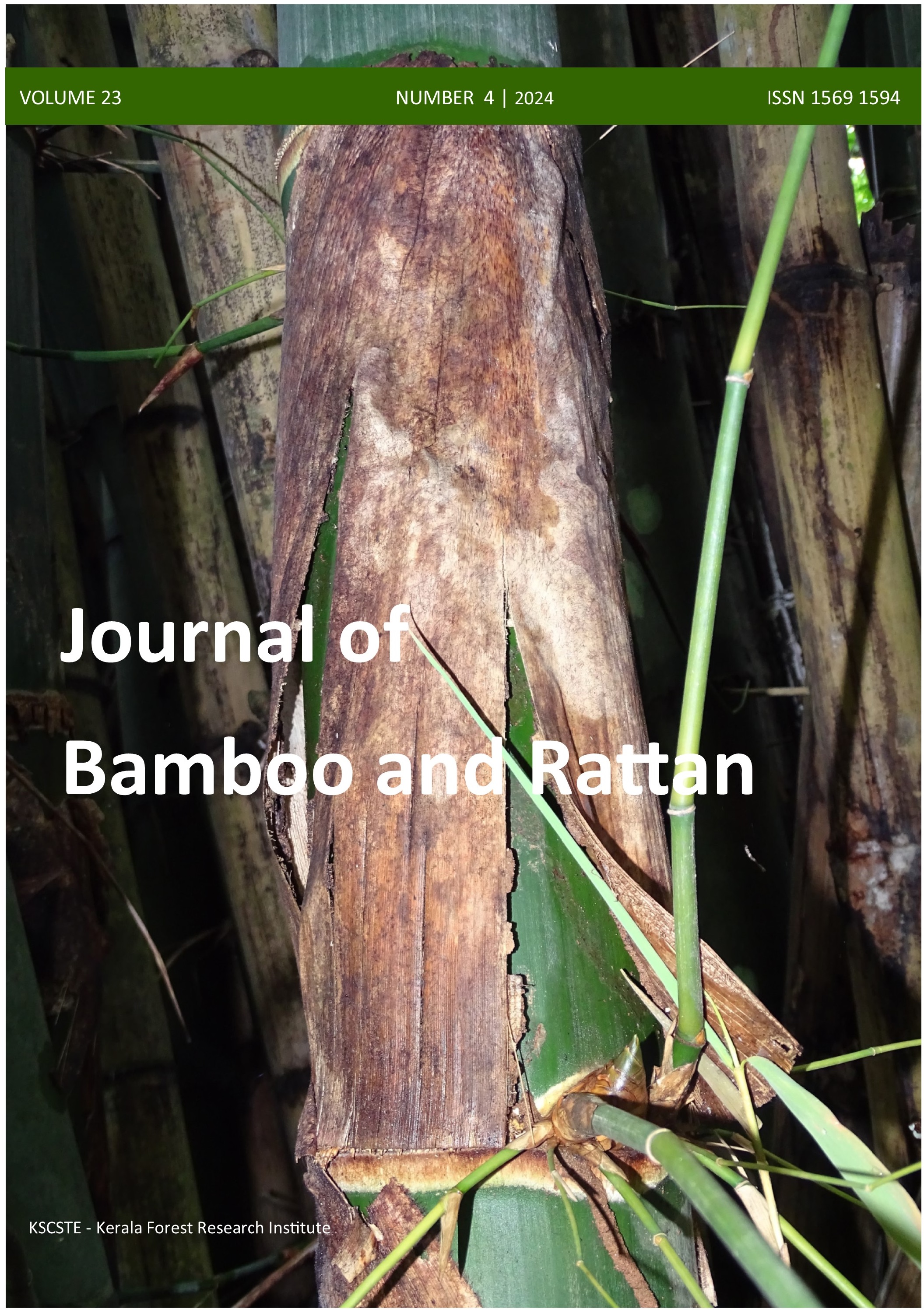In-Vitro Assessment of Host Suitability of Thirty-One Bamboo Species to the Invasive Polyphagous Pest Spodoptera frugiperda (J.E. Smith) (Lepidoptera: Noctuidae)
DOI:
https://doi.org/10.55899/09734449/jbr023401Keywords:
Fall-armyworm, host range, invasive insect, bamboo cultivation , pest riskAbstract
The fall armyworm (Spodoptera frugiperda) which is a highly invasive and polyphagous pest native to the Americas, has rapidly expanded its range, establishing itself across Asia, including India since 2018. Its arrival creates a serious biosecurity threat, not only to agricultural crops but also to non-traditional hosts such as forest and plantation species. Bamboos are critical to India’s forestry economy and ecosystem functions, remain largely unexplored as potential hosts. In this study, we conducted an in-vitro host suitability assessment of S. frugiperda across thirty-one commercially viable bamboo species using Ricinus communis as a positive control. Our results identified Dendrocalamus latiflorus, D. stocksii (=Pseudoxytenanthera stocksii), Thyrsostachys oliveri and T. siamensis as highly susceptible to larval feeding, indicating their vulnerability in open or plantation settings. In contrast, species such as D. strictus, P. madhavii, Ochlandra travancorica, Bambusa pallida, D. longispathus, O. ebracteata, and Schizostachyum brachycladum demonstrated strong resistance with minimal feeding. A network diagram constructed from the feeding response data visually delineates clusters of susceptible and resistant species; highlighting potential candidates for pest-resilient bamboo cultivation. Given the ecological and economic importance of bamboo in India, these findings underscore the urgent need to integrate pest risk assessment into bamboo agroforestry planning and breeding programs. This study serves as a first step toward understanding the host range expansion potential of S. frugiperda in forestry systems and provides valuable insights for future pest management and policy strategies concerning invasive pests in silviculture species.
References
Braman, S.K., Duncan, R.R., Engelke, M.C., Hanna, W.W., Hignight, K. and Rush, D., 2002. Grass species and endophyte effects on survival and development of fall armyworm (Lepidoptera: Noctuidae). Journal of economic entomology, 95(2), pp.487-492. https:// doi.org/10.1603/0022-0493-95.2.487
CABI. 2023. Spodoptera frugiperda (fall armyworm) datasheet. In: Invasive Species Compendium. [https:// www.cabi.org/isc]
Chen, Y., Ni, X. and Buntin, G.D. 2009. Physiological, nutritional, and biochemical bases of corn resistance to foliage-feeding fall armyworm. Journal of chemical ecology, 35, pp.297-306. https://doi.org/10.1007/ s10886-009-9600-1.
Dias, A.S., Marucci, R.C., Mendes, S.M., Moreira, S.G., Araujo, O.G., dos SANTOS, C.A. and Barbosa, T.A. 2016. Bioecology of Spodoptera frugiperda (Smith, 1757) in different cover crops.
Dos Santos, L.F.C., Ruiz-Sánchez, E., Andueza-Noh, R.H., Garruña-Hernández, R., Latournerie-Moreno, L. and Mijangos-Cortés, J.O., 2020. Leaf damage by Spodoptera frugiperda JE Smith (Lepidoptera: Noctuidae) and its relation to leaf morphological traits in maize landraces and commercial cultivars. Journal of Plant Diseases and Protection, 127, pp.103-109. https://doi.org/10.1007/s41348-01900276-y.
FSIR. 2023. Forest Survey of India Report. Ministry of Environment, Forest and Climate Change, Government of India.
Ganiger, P.C., Yeshwanth, H.M., Muralimohan, K., Vinay, N., Kumar, A.R.V., & Chandrashekara, K. (2018). Occurrence of the invasive fall armyworm, Spodoptera frugiperda (J.E. Smith) (Lepidoptera: Noctuidae), in maize in Karnataka, India. Current Science, 115(4), 621–623.
Goergen, G., Kumar, P.L., Sankung, S.B., Togola, A. and Tamò, M. 2016. First report of outbreaks of the fall armyworm Spodoptera frugiperda (JE Smith) (Lepidoptera, Noctuidae), a new alien invasive pest in West and Central Africa. PloS one, 11(10), p.e0165632.
Govaerts, R. 2009. World checklist of selected plant families. Royal Botanic Gardens. [Cited as Pseudoxytenanthera stocksii.].
Harish, E.R. and Krishnan, J.U. 2023. Cost-effective media for mass production of Bacillus thuringiensis Berliner for the management of taro caterpillar, Spodoptera litura Fabricius. J Entomol Res, 47(1), pp.8-15. DOI:10.5958/0974-4576.2023.00002.6
Sun, H., Wang, J., Li, H., Li, T. and Gao, Z., 2023. Advancements and challenges in bamboo breeding for sustainable development. Tree Physiology, 43(10), pp.1705-1717.https://doi.org/10.1093/treephys/tpad 086.
Krishnan, J.U., George, M., Ajesh, G., Jithine, J., Lekshmi, N.R. and Deepasree, M.I., 2016. A review on Paracoccus marginatus Williams, papaya mealybug (Hemiptera: Pseudococcidae). Journal of entomology and Zoology Studies, 4(1), pp.528-533.
Krishnan, J.U., Jayaprakas, C.A., Harish, E.R. and Rajeswari, L.S. 2020. Banana (Musa spp.)-an unseen umbrella crop? Insect diversity on Musa spp. in the Indo Pacific region. Oriental Insects, 54(3), pp.433-445. https://doi.org/10.1080/00305316.2019.1667926.
Montezano, D.G., Sosa-Gómez, D.R., Specht, A., Roque Specht, V.F., Sousa-Silva, J.C., Paula-Moraes, S.D., Peterson, J.A. and Hunt, T.E. 2018. Host plants of Spodoptera frugiperda (Lepidoptera: Noctuidae) in the Americas. African entomology, 26(2), pp.286-300. https://hdl.handle.net/10520/EJC-112bc26060
NBM. 2022. National Bamboo Mission Progress Report. Ministry of Agriculture and Farmers Welfare, Government of India.
Pamidi, L.S., Sekhar, J.C., Yathish, K.R., Karjagi, C.G., Rao, K.S., Suby, S.B. and Rakshit, S. 2025. Characterization of antixenosis and antibiosis resistance to the fall armyworm, Spodoptera frugiperda (JE Smith) in maize. Phytoparasitica, 53(1), p.4. https://doi.org/10.1007/s12600-024-01228-5
Sharanabasappa, S., Kalleshwaraswamy, C.M., Asokan, R., Swamy, H.M., Maruthi, M.S., Pavithra, H.B., Kavita Hegde, K.H., Shivaray Navi, S.N., Prabhu, S.T. and Goergen, G. 2018. First report of the fall armyworm, Spodoptera frugiperda (JE Smith) (Lepidoptera: Noctuidae), an alien invasive pest on maize in India.
Sharma, M.L. and Nirmala, C., 2015, September. Bamboo diversity of India: an update. In 10th World Bamboo Congress, Korea (pp. 17-22).
Downloads
Published
Data Availability Statement
The data that support the findings of this study are available from the corresponding author upon request.
Issue
Section
License
Copyright (c) 2025 Journal of Bamboo and Rattan

This work is licensed under a Creative Commons Attribution-NonCommercial-ShareAlike 4.0 International License.
How to Cite
Similar Articles
- Juan Francisco Aguirre-Cadena, Juan Francisco Aguirre-Medina, Jose Luis Lopez-Gonzalez, Nidia Belgica Pérez-De la O, Social and economic importance of new bamboo species established in three municipalities of the North Eastern Mountain range of Puebla, Mexico , Journal of Bamboo and Rattan: Vol. 22 (2023): Issue 2
- G. E Pereira, K. L. Santos, D. C. Ortiz, M. P. Guerra, L. R. Topanotti, Potential bamboo species for cultivation in the southern plateau of Atlantic Forest, Brazil , Journal of Bamboo and Rattan: Vol. 23 (2024): Issue 4
- Rajesh Tamang, Dr. Sanjeev Kumar Rai, Prof. Dr. Sangeeta Rajbhandary, Diversity and morphology of bamboo species in Nepal , Journal of Bamboo and Rattan: Vol. 24 (2025): Issue 1
- Sadananda Chingangbam, L.B. Singha, O.P. Tripathi, S. Dilip, K. Premkumar, C. Lulloo, Estimation of lesser known anti-nutrients; Phytic acid and Trypsin inhibitor from the edible bamboo shoots and their processed products of Arunachal Pradesh, India , Journal of Bamboo and Rattan: Vol. 22 (2023): Issue 1
- Alok Yadav, Sanchili Verma, Rahul Nishad, Kuldeep Chauhan, Bambusa vulgaris blooms along the Eastern plains of Uttar Pradesh , Journal of Bamboo and Rattan: Vol. 22 (2023): Issue 3
- E. Appiah-Kubi, F. W. Owusu, S. L. Tekpetey , C. Essien, Bamboo for housing in Ghana: challenges and prospects for the future , Journal of Bamboo and Rattan: Vol. 13 (2014): Issue 3 & 4
- Thiti Wanishdilokratn, Jirapa Wanishdilokratn, Physical and mechanical properties of Dendrocalamus giganteus from difference zones in Long district, Phrae province, Thailand , Journal of Bamboo and Rattan: Vol. 23 (2024): Issue 2
- Koranat Narkpiban, Piangkhwan Kruapoo, Rangsan Koodsamrong, Chaiyasit Keawcharoon, Najjapak Sooksawat, Characterization and property evaluation of low-cost electrically conductive bamboo charcoal from Dendrocalamus sericeus Munro. , Journal of Bamboo and Rattan: Vol. 22 (2023): Issue 1
- Shweta B. Kukreti, Aswathi Rajeev, Review on bamboo treatment in India: A species-specific approach for enhanced durability , Journal of Bamboo and Rattan: Vol. 23 (2024): Issue 1
- E. Appiah-Kubi, F.W. Owusu, S. L. Tekpetey, C. Essien, H. Seidu , Investigating the mechanical properties of some bamboo species for efficient utilization in Ghana , Journal of Bamboo and Rattan: Vol. 13 (2014): Issue 3 & 4
You may also start an advanced similarity search for this article.

